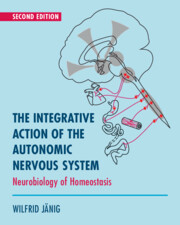Book contents
- The Integrative Action of the Autonomic Nervous System
- Reviews
- The Integrative Action of the Autonomic Nervous System
- Copyright page
- Dedication
- Contents
- Foreword to the Second Edition
- Foreword to the First Edition
- Preface
- Abbreviations
- Introduction The Autonomic Nervous System and the Regulation of Body Functions
- Part I The Autonomic Nervous System: Functional Anatomy and Interoceptive Afferents
- Part II Functional Organization of the Peripheral Autonomic Nervous System
- Part III Transmission of Signals in the Peripheral Autonomic Nervous System
- Part IV Representation of the Autonomic Nervous System in the Spinal Cord and Lower Brain Stem
- Chapter 8 Anatomy of Central Autonomic Systems
- Chapter 9 Spinal Autonomic Systems
- Chapter 10 Regulation of Organ Systems by the Lower Brain Stem
- Part V The Centers of Homeostasis in the Mesencephalon and Hypothalamus and Their Telencephalic Control
- Index
- References
Chapter 10 - Regulation of Organ Systems by the Lower Brain Stem
from Part IV - Representation of the Autonomic Nervous System in the Spinal Cord and Lower Brain Stem
Published online by Cambridge University Press: 16 July 2022
- The Integrative Action of the Autonomic Nervous System
- Reviews
- The Integrative Action of the Autonomic Nervous System
- Copyright page
- Dedication
- Contents
- Foreword to the Second Edition
- Foreword to the First Edition
- Preface
- Abbreviations
- Introduction The Autonomic Nervous System and the Regulation of Body Functions
- Part I The Autonomic Nervous System: Functional Anatomy and Interoceptive Afferents
- Part II Functional Organization of the Peripheral Autonomic Nervous System
- Part III Transmission of Signals in the Peripheral Autonomic Nervous System
- Part IV Representation of the Autonomic Nervous System in the Spinal Cord and Lower Brain Stem
- Chapter 8 Anatomy of Central Autonomic Systems
- Chapter 9 Spinal Autonomic Systems
- Chapter 10 Regulation of Organ Systems by the Lower Brain Stem
- Part V The Centers of Homeostasis in the Mesencephalon and Hypothalamus and Their Telencephalic Control
- Index
- References
Summary
Regulation of the cardiovascular system, the respiratory system and the gastrointestinal tract (GIT) is represented in the lower brain stem. These control systems require precise coordination and are closely integrated, which is reflected in the anatomy and physiology of the neural substrates of these control systems. Included in this integration are the final autonomic pathways, the enteric nervous system and the spinal autonomic circuits. The circuits in the medulla oblongata are under the control of the upper brain stem, hypothalamus and telencephalon. Neurons involved in regulation of arterial blood pressure and respiration are situated in rostrocaudally organized columns of neurons in the ventrolateral medulla (VLM). The rostral VLM is a sympathetic cardiovascular premotor nucleus mediating reflexes to sympathetic cardiovascular preganglionic neurons such as arterial baroreceptor, arterial chemoreceptor and other reflexes. The caudal raphe nuclei of the medulla oblongata are involved in thermoregulation and regulation of energy balance. The respiratory pattern in cardiovascular neurons is generated by the "common cardiorespiratory network" in the VLM. Neural control of the GIT by the lower brain stem is exerted by multiple reflex circuits consisting of vagal afferents from the GIT, neurons in the nucleus tractus solitarii and parasympathetic preganglionic neurons projecting to the GIT.
Keywords
- Type
- Chapter
- Information
- The Integrative Action of the Autonomic Nervous SystemNeurobiology of Homeostasis, pp. 292 - 352Publisher: Cambridge University PressPrint publication year: 2022
References
Specific References for this Box
See further key references here.
Suggested Reading
All references cited in the text are available online at www.cambridge.org/janig.

